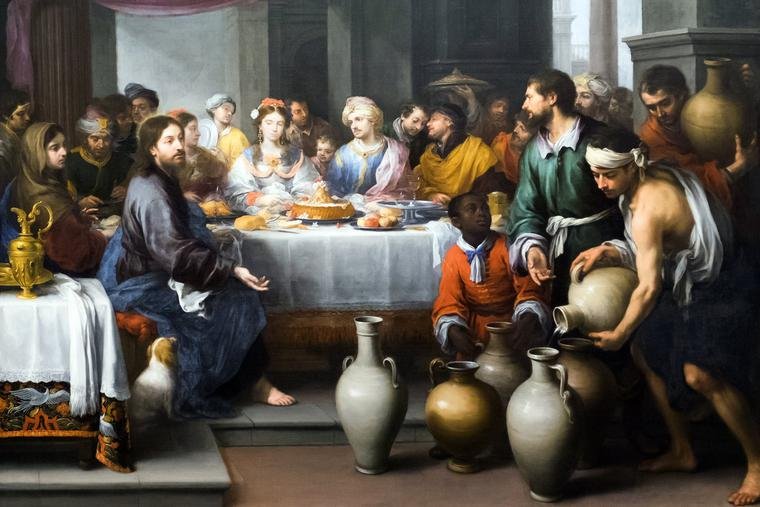yep
By: Mission Team
The Rosary, the stereotypical accessory for any Catholic’s rearview mirror, a beautiful biblically based meditative prayer, and the thing with beads and a crucifix, however, you like to describe it, this tradition of the Catholic church is a wonderful way to get to know Christ through His Blessed Mother. (What is the Rosary, and why is it so important?!? If you find yourself asking this question, please read a blog written by a teammate of mine at https://www.amazingnation.org/Blog/n/The-Importance-of-the-Rosary-)
It can be easy to think about the sorrowful, glorious, and joyful mysteries of the Rosary. Those titles are pretty self-explanatory. But isn’t there another set of mysteries in the rosary? One that some of us (*cough* *cough* me.) have a hard time really remembering? Well, this one cool guy named Pope St. John Paul ll added a new group of mysteries to the previous three (Joyful, Sorrowful, and Glorious). In October of 2002, the “Luminous” mysteries were added. These mysteries I didn’t understand. It seemed to me that these were just parts of Jesus’s life that didn’t fit into the other categories. A random list of events, I never dove into them deeply. That was until I started reading my bible more. Now here is where you would expect me to talk about how I studied bible history, or some other complicated philosophical thing you didn’t quite understand in Sunday school. That is not the case here! The initial pull towards the “Luminous” came from a yellow pencil. As one who is an artist, I do not appreciate when markers or highlighters bleed into my paper. Especially when dealing with paper as thin as when used in bibles! One accidental drop of ink and you have water damage 9 ½ pages in! Fortunately for me, some wise person suggested using colored pencils instead of highlighters when taking notes in scripture. This is great as insights stand out and help me focus. In an attempt to stay organized, I decided to use a color system. I cannot remember what half of them meant, but I had different colors portraying encouragement, redemption, conviction, and lastly, truth. The verses that spoke truth to me helped me to better know who Christ is. When I think of truth, I imagine a ray of sunlight enlightening the darkness of my intellect, drawing me closer to the source. Or put more simply, the yellowish glow of a lightbulb serves as a metaphor for new ideas. Thus my color for truth is Yellow. This brings me back to the prize winner's word of the day, Luminous. To illuminate is to bring light to a situation. To unveil the truth, so to say.
How do the mysteries mentioned above shine God’s light through Christ though? Why are they so special that apparently this previously thought “random category” is now being illustrated as a guide to truth? Just take a look at The Baptism of Jesus in the Jordan. Here we see Christ, who is free from all sin, as He is *literally* God, allowing His locust-eating, camel-skin-wearing, cousin, John to baptize Him along with those who follow John’s message urging repentance. He didn’t need freedom from sin but rather wished to serve as an example for many people in humility and piety. After emerging from the waters, After Jesus was baptized, he came up from the water, and behold, the heavens were opened [for him], and he saw the Spirit of God descending like a dove [and] coming upon him. 17 And a voice came from the heavens, saying, “This is my beloved Son,[c] with whom I am well pleased.”(Matthew 3:16-17) God the Father wished to glorify the Son in a profound way, illustrating Christ’s divinity. Boom. Truth. Then there was the wedding banquet that Christ, His close friends, and even His mother were invited to. A problem arose when the bride and groom ran out of wine. In those days, that was a tragedy for wedding parties! Just imagine being a kid(or in my case, an Adult) and running out of Caprisuns at a party, and how devastating that is. The word of this dilemma spread quickly. Soon the news reached the Blessed Mother and she felt empathy for the wedding party. She brought the issue to her Son. After He had tried to reason that it wasn’t time for His miracles to be public, He still listened to His mom, who instructed the servants to do whatever Jesus asked of them. Lo and behold, Jesus turned large jars of water into the most flavorful wine. 11 Jesus did this as the beginning of his signs[g] in Cana in Galilee and so revealed his glory, and his disciples began to believe in him. (John 2:11) In Jesus's life, there was a time for Him to go public when He started preaching to those around Him and shared the Good News. This we call the proclamation of the gospel.
Jesus didn't have to do miracles. He didn't have to show mercy to the very people who were sinning, but this also shows us the type of person Jesus is. That He is a redeemer. A pursuer. He didn't come to pat the holy people on the back and say, "Good job for being holy." He came and entered the lives of tax collectors and Gentiles and prostitutes, to let them know that there is hope. Now you could be finished reading this blog and think it was cool or maybe you're wondering how to win back the time you lost while reading something that brought you no interest, but the fact of the matter is that I don't care. What I do care about is for you to open your heart to Truth and give God a chance to shine light in your life. Be a light. Get out there and encourage people. You never know when something might change another's life for the better.




